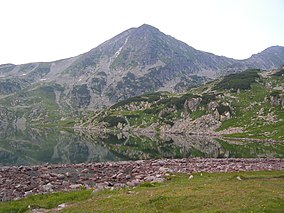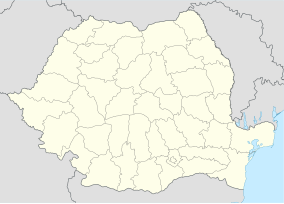Retezat National Park
| Retezat National Park | |
|---|---|
| Parcul Național Retezat | |
 Retezat Mountains, near camping site Bucura | |
Location within Romania | |
| Location | |
| Nearest city | Lupeni |
| Coordinates | 45°20′N 22°50′E / 45.34°N 22.83°E[1] |
| Area | 38047 hectares (94020 acres) |
| Established | 2000[2] |
| Website | retezat.ro |
The Retezat National Park (
Retezat is particularly notable for its biodiverse flora, with over 1,000 species of plants present within the park. It is also home to some of the last remaining pristine old-growth forests in Europe. Despite its protected status, recent decades have seen an increase in damaging activities such as logging and sheep-grazing in the park, as well as threats to its status as public propriety.
History
The Retezat region has been a subject of scientific interest, particularly with regard to its flora, since at least the early 19th century.[3] During the 1930s, several scientific personalities like Alexandru Borza and Emil Racoviţă campaigned for the creation of nature reserves in the country.[4] In 1935, the Tătărescu government set aside 100 square kilometers of the Retezat Mountains, creating the country's first national park. It took four more years for legislation to be passed regarding the park's status, paving the way for all future protected areas of Romania.[4]
In 1979,
Since the 1990s
In 2006 the Romanian state decided in favor of heirs to the Austro-Hungarian aristocratic family Kendeffy, who claimed 10,000 hectares of land in the Retezat Mountains, including large tracts of the park, under a law allowing the restitution of propriety seized by previous regimes. The Romanian Academy, who was granted the land in the 1930s, challenged the decision. After a lengthy trial, the land restitution was deemed illegal by a 2022 court decision, and the park returned to being state propriety.[9][10]

Description
The park contains more than sixty peaks over 2,300 metres (7,500 ft) and about eighty

Flora
The flora of Retezat demonstrates "exceptional biodiversity", consisting of approximately 1,190 plant species, of which 130 have the "endangered" or "vulnerable" status. More than a third of Romania's flora can be found in this area.[8][14] Mountain pine and juniper habitats are dominant, with spruce and rhododendron also common.[8]
The park is often described as containing ”Europe's last intact forest", as it harbors one of the few remaining intact old-growth forest landscapes and the largest single area of pristine mixed forest on the continent.[15][16][17] The Gemenele ("The Twins" in Romanian) scientific reserve is a strictly protected area of the park enclosing 1,800 hectares of intact old-growth forest.[5]
Fauna

The
The park is also home to more than a hundred bird species, many of which are protected in Romania. Present species include the western capercaillie, common kingfisher, lesser spotted eagle, black grouse, short-toed snake eagle, Eurasian eagle-owl, corn crake, back woodpecker, peregrine falcon, collared flycatcher, and the golden eagle, which is depicted on the park's logo.[18][19] The park was included by BirdLife International among its Important Bird Areas.[21]
Over 1000 species of butterflies were identified in the area, with the park containing two European Prime Butterfly Areas.[19][22]
See also
References
- ^ eunis.eea.europa.eu - Retezat National Park (coords); retrieved on June 14, 2012
- ^ (in Romanian) cdep.ro - Legea Nr.5 din 6 martie 2000, publicată în Monitorul Oficial al României, Nr.152 din 12 aprilie 2000; retrieved on June 14, 2012
- ISBN 978-3-031-05618-5.
- ^ a b Guţă, Daniel (6 March 2018). "Savanţii care au transformat Retezatul în primul parc naţional al României: "În aceşti munţi vom sorbi aerul de libertate lăsat moştenire de Craiul Decebal"". Adevărul. Retrieved 22 August 2023.
- ^ ISBN 978-2-8317-0286-5.
- ^ "Resolution CM/ResDip(2008)2 on the award of the European Diploma of Protected Areas to the Retezat National Park (Romania)". Council of Europe. 2 July 2008. Retrieved 22 August 2023.
- ^ Kiss, Imre; Alexa, Vasile (November 2014). "Ecological Restoration Activities for Long-Term Preservation of the Common Habitats in the Retezat National Park". Annals of the Faculty of Engineering Hunedoara - International Journal of Engineering. 13 (4): 213–216.
- ^ a b c Kiss, Imre; Alexa, Vasile (November 2014). "Renaturation Activities of Mountain Habitats with Creeping Mountain Pine Seedlings in Retezat National Park". Annals of the Faculty of Engineering Hunedoara - International Journal of Engineering. 12 (4): 353–358.
- ^ Chirileasa, Andrei (11 November 2022). "Romanian court rules that 10,000ha of forest, including protected land, was illegally 'restituted'". Romanian Insider. Retrieved 24 August 2023.
- ^ "S-a decis! Parcul Retezat revine în proprietatea statului român". Jurnalul Național. 11 November 2022. Retrieved 24 August 2023.
- ^ "Parcul Național Retezat". The National Agency for Protected Natural Areas. 29 September 2020. Retrieved 16 September 2023.
- ^ "Retezat National Park". Romania Tourism. Retrieved 16 September 2023.
- ^ (in Romanian) apmhd.anpm.ro - Agenţia pentru Protecşia Mediului Hunedoara; retrieved on June 14, 2012
- ISSN 1040-6182.
- ISSN 0261-3077. Retrieved 24 August 2023.
- ISBN 978-1-78701-074-1.
- ^ Dejeu, Călin (29 May 2021). "CCSG Member News: Conserving the integrity of Retezat National Park, Romania". Conservation Corridor. Retrieved 24 August 2023.
- ^ a b "Flora și Fauna". Politehnica University of Timișoara: Parcul Național Retezat. 30 January 2022. Retrieved 16 September 2023.
- ^ a b c d "Despre specii". The National Agency for Protected Natural Areas. 21 April 2014. Retrieved 16 September 2023.
- ^ "Biodiversity". Parcul Național Retezat.
- ^ "Retezat Mountains". BirdLife Data Zone. 2023. Retrieved 16 September 2023.
- S2CID 36168227.
External links
- Official site
- Map of the Park
- Jiu Valley Portal - the home of the Official Jiu Valley City Websites and a gateway to the Retezat National Park and other destinations in the Transylvanian Alps
- Maps of the Retezat and other mountain ranges in the Transylvanian Alps
- Touristic Maps of the Retezat Mountains


